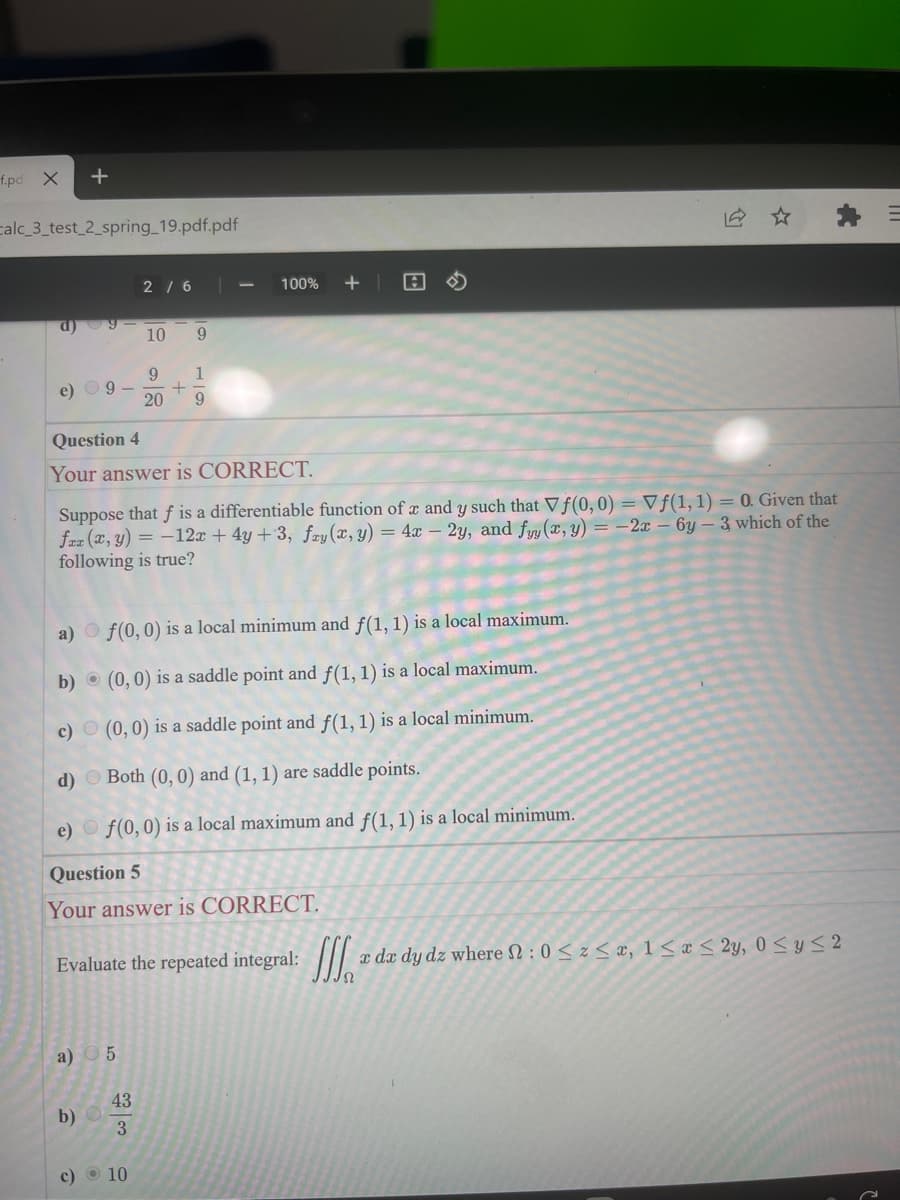Question 4 Your answer is CORRECT. Suppose that f is a differentiable function of x and y such that Vf(0, 0) = Vfƒ(1, 1) = 0. Given that fax (x, y) = -12x + 4y +3, fay(x, y) = 4x - 2y, and fyy (x, y) = -2x - 6y-3 which of the following is true? a) b) c) d) e) f(0, 0) is a local minimum and f(1, 1) is a local maximum. (0, 0) is a saddle point and f(1, 1) is a local maximum. (0, 0) is a saddle point and f(1, 1) is a local minimum. Both (0, 0) and (1, 1) are saddle points. f(0, 0) is a local maximum and f(1, 1) is a local minimum.
Question 4 Your answer is CORRECT. Suppose that f is a differentiable function of x and y such that Vf(0, 0) = Vfƒ(1, 1) = 0. Given that fax (x, y) = -12x + 4y +3, fay(x, y) = 4x - 2y, and fyy (x, y) = -2x - 6y-3 which of the following is true? a) b) c) d) e) f(0, 0) is a local minimum and f(1, 1) is a local maximum. (0, 0) is a saddle point and f(1, 1) is a local maximum. (0, 0) is a saddle point and f(1, 1) is a local minimum. Both (0, 0) and (1, 1) are saddle points. f(0, 0) is a local maximum and f(1, 1) is a local minimum.
Calculus: Early Transcendentals
8th Edition
ISBN:9781285741550
Author:James Stewart
Publisher:James Stewart
Chapter1: Functions And Models
Section: Chapter Questions
Problem 1RCC: (a) What is a function? What are its domain and range? (b) What is the graph of a function? (c) How...
Related questions
Question

Transcribed Image Text:f.pd X
calc_3_test_2_spring_19.pdf.pdf
d)
e) 9-
a)
b)
Question 4
Your answer is CORRECT.
Suppose that f is a differentiable function of x and y such that Vf(0, 0) = Vf(1, 1) = 0. Given that
fax (x, y) = -12x + 4y +3, fry (x, y) = 4x - 2y, and fyy(x, y) = -2x - 6y-3 which of the
following is true?
c)
d)
f(0, 0) is a local minimum and f(1, 1) is a local maximum.
(0, 0) is a saddle point and f(1, 1) is a local maximum.
(0, 0) is a saddle point and f(1, 1) is a local minimum.
Both (0, 0) and (1, 1) are saddle points.
e) f(0, 0) is a local maximum and f(1, 1) is a local minimum.
Question 5
Your answer is CORRECT.
Evaluate the repeated integral: a da dy dz where : 0 ≤ z ≤æ, 1 ≤ * ≤ 2y, 0 ≤ y ≤ 2
a) 5
b)
43
2 / 6
| من
10 9
9 1
+
20 9
3
100% + A
c) 10
Expert Solution
This question has been solved!
Explore an expertly crafted, step-by-step solution for a thorough understanding of key concepts.
Step by step
Solved in 2 steps with 1 images

Recommended textbooks for you

Calculus: Early Transcendentals
Calculus
ISBN:
9781285741550
Author:
James Stewart
Publisher:
Cengage Learning

Thomas' Calculus (14th Edition)
Calculus
ISBN:
9780134438986
Author:
Joel R. Hass, Christopher E. Heil, Maurice D. Weir
Publisher:
PEARSON

Calculus: Early Transcendentals (3rd Edition)
Calculus
ISBN:
9780134763644
Author:
William L. Briggs, Lyle Cochran, Bernard Gillett, Eric Schulz
Publisher:
PEARSON

Calculus: Early Transcendentals
Calculus
ISBN:
9781285741550
Author:
James Stewart
Publisher:
Cengage Learning

Thomas' Calculus (14th Edition)
Calculus
ISBN:
9780134438986
Author:
Joel R. Hass, Christopher E. Heil, Maurice D. Weir
Publisher:
PEARSON

Calculus: Early Transcendentals (3rd Edition)
Calculus
ISBN:
9780134763644
Author:
William L. Briggs, Lyle Cochran, Bernard Gillett, Eric Schulz
Publisher:
PEARSON

Calculus: Early Transcendentals
Calculus
ISBN:
9781319050740
Author:
Jon Rogawski, Colin Adams, Robert Franzosa
Publisher:
W. H. Freeman


Calculus: Early Transcendental Functions
Calculus
ISBN:
9781337552516
Author:
Ron Larson, Bruce H. Edwards
Publisher:
Cengage Learning